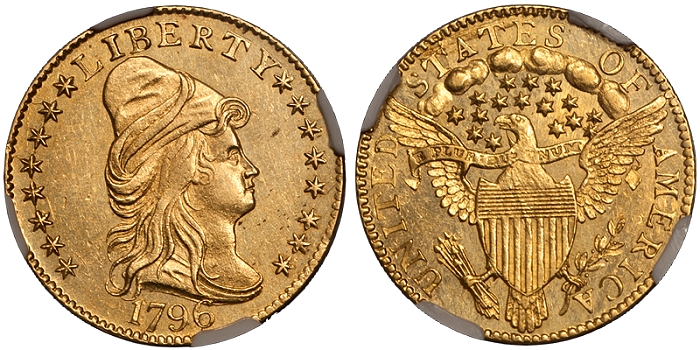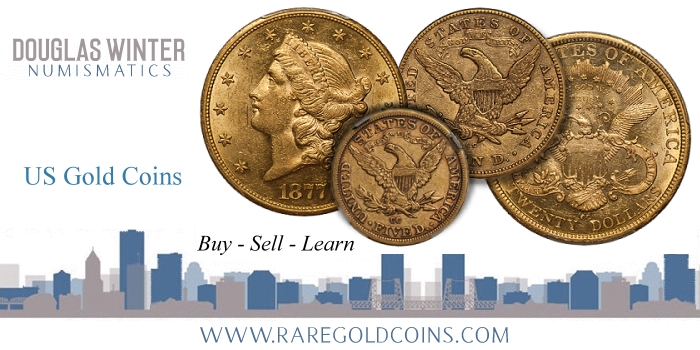
By Doug Winter – RareGoldCoins.com ………..
Production of the gold quarter eagle denomination began in 1796. The initial production run of 932 coins featured the No Stars obverse. In the very beginning of 1797, another 432 or so quarter eagles dated 1796 were made; these featured the With Stars obverse which was employed through 1807.
While the 1796 No Stars is better-known, the 1796 With Stars is considerably rarer with a total of 40 or so pieces estimated to exist in all grades. In my experience, the 1796 With Stars is at least twice as rare as its No Stars counterpart, but it is not as well-known due to the No Stars having status as a distinct one-year design type gold quarter eagl.
It is believed that five to seven 1796 No Stars quarter eagles exist in Uncirculated. I have the pleasure of announcing that my firm Douglas Winter Numismatics just purchased the famous John Whitney Walter example graded MS63★ by NGC for $324,000 in Stacks Bowers November 2017 Baltimore auction. This coin was bought for an East Coast specialist who with my expertise has put together one of the finest sets of early quarter eagles (1796-1834) ever assembled.
In my years of working with this collector, we have had a few opportunities to purchase the right 1796 With Stars. Much of this has to do with the rarity of this coin in high grades. The finest known, the remarkable PCGS/CAC MS65 Byron Reed coin, sold for $1,006,250 in the Heritage 2008 FUN auction and it is a centerpiece of the Simpson collection. Another nice Uncirculated example is in the Smithsonian collection and, obviously, is not an option. This left the collector with three viable coins. The first was the other MS63 from the Whitney collection, now graded MS63 by PCGS and last offered in the Heritage 2012 ANA, where it brought $329,000. We passed on this coin due to its odd coloration and the presence of a detracting mint-made lintmark located right on Liberty’s throat.
The second option was the PCGS/CAC MS62 Earle-Judd-Hayes coin which was offered as Lot 1117 in the September 2015 Pogue sale. The collector and I both liked this coin very much and we actively bid on it, but we came up short when it realized a strong $440,625.
The third and final option was the second MS63 from the famous Whitney collection of 1796 coinage. It had brought exactly the same price as the coin now graded PCGS MS63 sold for ($115,000) when offered in 1995 and it had bounced around until it was last sold for $287,500 by Stacks Bowers in their 2011 ANA auction.
NOTE: There is a nice unencapsulated 1796 With Stars in the Bass collection that should grade MS63 to MS64 but its fate remains uncertain. The Eliasberg/Price coin, graded MS62 by NGC and previously a PCGS MS61, was another semi-viable option but it didn’t appear to be available after my inquiries to its present owner were met with silence.
The collector and I analyzed both the coin and the opportunity which we were presented. The PCGS MS65 wasn’t likely to come up for sale in the next decade, and the PCGS MS63 was a coin which neither of us cared for. This left the PCGS MS62 (which was also not likely for sale anytime soon and clearly not at the dollar amount with which we felt comfortable) and the NGC MS63★ which we both liked and which made sense at the likely price it would bring. After much discussion, we agreed on a price for me to bid and, as luck would have it, we bought the coin at our exact bid.
The coin itself is unusual for the issue in that it is exceptionally well-detailed and it has reflective surfaces on both the obverse and the reverse. It is clearly not a presentation piece or special strike, but its reflectiveness is similar to that seen on the Byron Reed Gem and the Pogue coin.
One of the more unusual diagnostic features shown by this issue is the heavy die scratches above TAT in STATES which is unique to this reverse. These are seen on all 1796 With Stars quarter eagles and this is the only use of this reverse die. In addition, it has a distinctive obverse with 16 stars employed; all other quarter eagles of this type (1797-1807) have obverses which show 13 stars.
As a dealer who specializes in United States gold coinage, I get to handle some really interesting pieces. This 1796 With Stars is the single best example of this issue that I have handled, and it rates as one of the more exciting coins my firm has sold in 2017.





